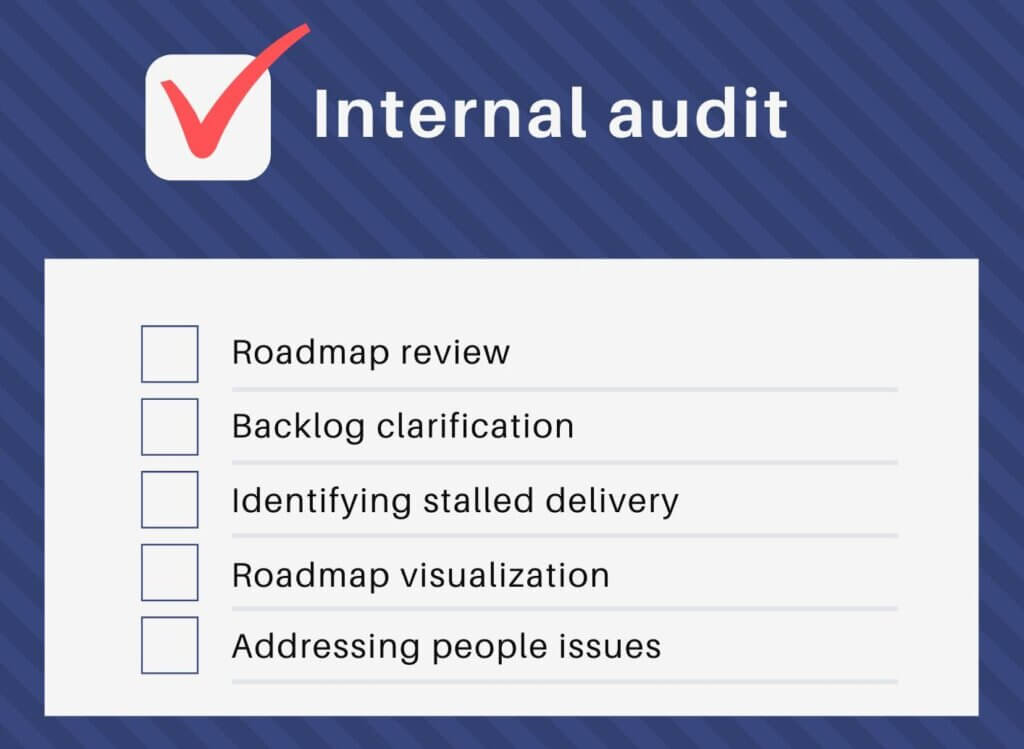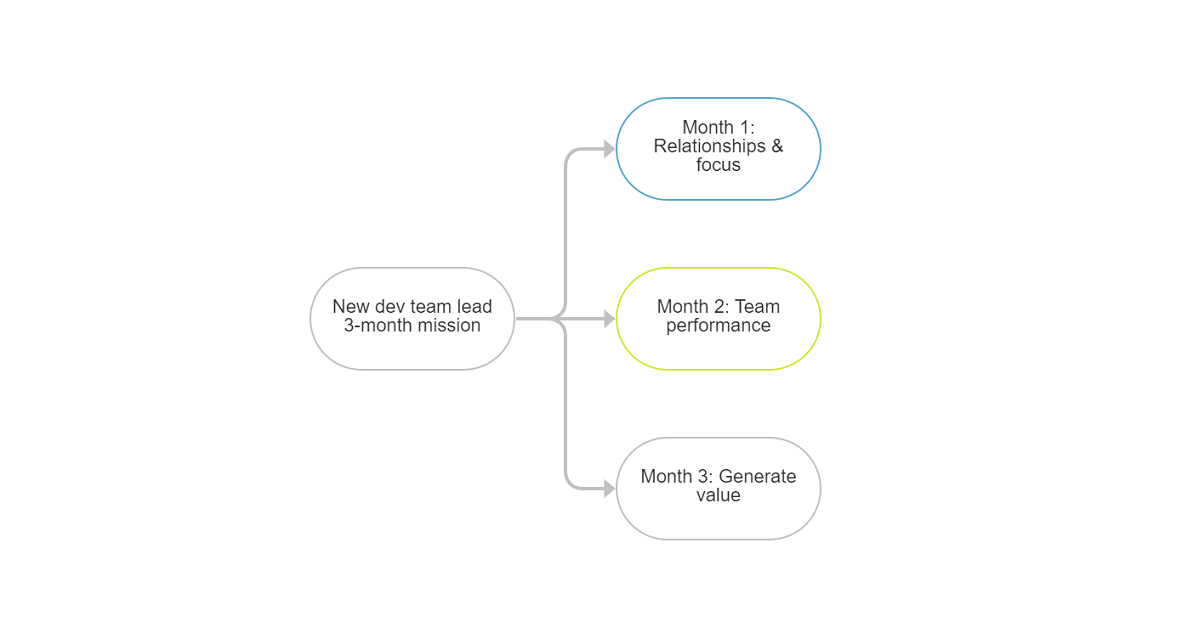Practical weekly strategies to set your team up for early success
If you’ve recently stepped into a new role as a dev team lead, you might be feeling the pressure. This is your chance to make a strong first impression — but it’s not something that comes naturally. Having a battle plan is what sets the winners apart from the losers.
In this post, I’m sharing practical tips and best practices I’ve developed through helping dozens of tech leaders succeed. These aren’t just theories — they’re real strategies that work.
The 30-60-90-day contract
Your goal for the first three months as a lead should be clear and simple:
“In three months, I’ll embrace the new dev team, complete an internal audit, and present my battle plan.”
- Month 1: Focus entirely on understanding and supporting the team.
- Month 2: Concentrate on optimizing team performance.
- Month 3: Before the probation period ends, present your audit results and proposed improvements, and review your added value.
This is how masters make contracts: it’s not just about setting goals, as those can change. It’s not about delivery, which is just the work itself. It’s about becoming a partner in crime, not a subordinate.
TIPS:
- Take a week-by-week approach, focusing on achieving clear goals.
- Allocate 1-2 days each week for your internal audit journey.
- Mark day 90 in your calendar as a milestone; this will be your deadline.
- Schedule monthly reviews with your manager and stakeholders to assess progress and receive constructive feedback.
Here’s how to break that contract down week by week, ensuring you cover every base:
Month 1: Owning your team’s focus
This month, your priority is building relationships and understanding the team’s dynamics.
Week 1: Build relationships
If you don’t have relationships, you’ll fail. Reorganize your calendar with what’s important: relationship building.
If you jump straight into tasks, prioritization, and delivery without first building relationships, you’ll find yourself without support when times are hard.
- Schedule two catch-up sessions each week with your manager.
- Set up informal face-to-face conversations with your peers and direct reports.
- Attend all meetings and ceremony sprints.
Waiting two months into your new role as a team lead to do this is too late; it sends the message that you prioritize the delivery pipeline over people, leading to decreased team satisfaction.
Your success depends on people. Most dev team leads are let go due to poor communication or relationship issues rather than technical skills. If you neglect relationship-building, it’s unlikely you’ll succeed.
TIP: Avoid getting caught up in highly operational work. In most companies, delivering half of the quarterly roadmap or sprints makes you a hero. Communicate to your manager that you need time to ensure your team is performing at a high level. It may sound crazy, but it’s fair.
Week 2: Learn the landscape
Block off time for learning. Focus on understanding your responsibilities regarding the team and the product/technical roadmap. You can’t effectively set and manage priorities if you’re unclear about what you’re supposed to achieve.
Differentiate yourself by showing a genuine interest in the product and business.
- Ask the CPO to explain the reasoning behind the product strategy, and they’ll kiss your feet.
- Understand the business model, revenue streams, and pricing strategy.
- Engage with customers to gain insight into their needs and experiences.
This approach will help you establish the right priorities early on and position yourself for success in your new leadership role.
Week 3: Set realistic expectations
Set expectations wisely. Challenge the status quo to guarantee you meet delivery expectations.
Question unrealistic roadmap timelines and make adjustments based on relevant data. Ask your direct manager or product manager, “How can we accomplish XYZ within this timeframe? If it’s not feasible, what alternatives can we explore?”
As the one responsible for your team’s delivery, saying “Yes, I can do that” when you can’t and hoping for a miracle won’t lead to success. It’s a losing strategy. Advocate for realistic expectations for your team before it’s too late.
Week 4: Create a team charter
Create a team charter defining the team’s purpose, communication protocols, roadmap, current workload, and knowledge base. This reduces communication bottlenecks by clearly showing the team’s processes and objectives.
The team charter protects you from becoming a yes-man.
It’s an effective communication tool for ensuring team alignment and focus, protecting you from external interruptions. Without it, you’ll likely be overwhelmed by requests from sales and product managers, making it difficult to push back. This could lead to being overloaded with initiatives that you won’t have the capacity to complete.
The end of month 1
Evaluate your progress with your manager by saying, “I’ve started building relationships, I’ve gotten to know our customers, I understand the product strategy and its purpose, and I’ve created a team charter.”
Ask for constructive feedback, and then you can consider your first month a success.
I guarantee they’ll view your work positively if you take this approach. It sets a much different tone than saying, “We completed two additional sprints and delivered something.”
Month 2: Owning your team’s productivity
Month 2 is where you’ll focus on optimizing team productivity.
Week 5: Understand how your company operates
This week, learn the company’s operational workflows, including its processes, tools, roadmap, and OKRs. Know how the company delivers value by tracing the entire journey from ideation to the point when new functionalities reach the customer.
If you’re not familiar with how the company operates, you won’t be able to see the bigger picture or make informed decisions about what needs improvement.
TIP: Don’t underestimate the importance of communication channels. If you only have one, it’s a mess. Every software development team should have separate channels for public issues, private matters, and escalations.
Week 6: Conduct your audit

Now that you understand the company’s processes, conduct an internal audit of your team. Review their workload, capacity, and performance using data from one-to-ones, Jira, and other sources to know how things work in reality. Focus on:
- Time spent on the roadmap. Teams often spend 60% of their time on non-roadmap tasks, delivering only half of what’s planned. If business-as-usual tasks like bug fixes dominate, identify interruptions and create a prioritization scheme (1 to 5) to evaluate tasks. Review your backlog from the last three sprints; if most tasks are normal priorities, improve your prioritization system.
- Backlog clarification. Software teams can accumulate massive backlogs of ideas over time. This leads to a situation where no one reviews the backlog anymore and instead uses personal judgment for prioritization. Regularly reviewing the backlog is an easy way to boost efficiency.
- Stalled delivery. Identify root causes of delivery delays, such as frequent test failures or a lack of confidence in releases. Encourage the team to prioritize closing old tasks before starting new ones.
- Roadmap visualization. Ensure your team charter includes a roadmap visualization to clarify focus and priorities. This prevents individuals outside the team from dictating roadmap content.
- People. Address challenges like underperforming team members, ineffective product management, or strained stakeholder relationships. Tackle these inefficiencies directly.
Establish your priorities by asking yourself, “What should I optimize? How can I improve system and team performance?”
Week 7: Make your first improvement
Using insights from your audit, make a small but impactful improvement. Choose a minor inefficiency, such as enhancing the two-level code review, fixing the pipelines, or addressing personnel issues.
Show that your mission is to improve things. If you accept ‘the way things are’, you’ll never win.
Don’t be the person making changes in the first week to assert your authority. Listen, understand how things work, and then propose the most impactful improvements.
Week 8: Strengthen relationships further
Reinforce your commitment to building relationships by supporting those around you and driving your team’s development. By now, you should be well-positioned to help your reports, peers, and stakeholders.
Support those around you to maintain momentum in your new role. Without it, connections grow cold.
Don’t chase the big wins at this stage. You understand your team’s dynamics, strengths, weaknesses, opportunities, and challenges. Focus on helping each person make one small improvement. Avoid taking on large tasks or missions right away; that won’t benefit anyone. Instead, prioritize continuous improvement through incremental changes.
Month 3: Owning your team’s success
With two months down, it’s time to position yourself as the leader your team needs.
Week 9: Gain a company-wide perspective
Expand your understanding of how things operate across the company. The company should provide this, but if they don’t, ask for:
- Communication and HR protocols
- Career progression framework
- Criteria for promotions, layoffs, and recruitment
- Escalation protocols
- When to declare a bug as a blocker
Clearly defining contracts will significantly reduce disruptions for your team.
Without this clarity, you risk misunderstandings and conflicts. Engage with product management, marketing, and if you’re ambitious, sales.
Week 10: Present your audit findings
Summarize your findings from discussions with various stakeholders and support them with data. Quantify your delivery over the past two quarters, identify disruptions, and compare the time spent on key priorities (the roadmap) to business-as-usual tasks.
Create a timeline highlighting the two most critical areas for improvement starting next month, along with a roadmap for the following quarters. Present this proposal to your manager, stakeholders, and team members. This approach will set you apart.
Transition from a dynamic where your manager makes decisions for you to one where you take charge and say, “Let me handle this; I’ll make the call.”
Week 11: Address larger issues
Now that you have data and momentum, begin tackling larger systemic issues. This doesn’t mean you need to resolve them completely, but you should initiate action or signal your intent to address what you believe is most important.
Be a change agent. Show that your lifelong mission is driving meaningful transformations.
E.g.: Instead of resetting your backlogs and starting from scratch at the end of each quarter, consider proposing, “For the final sprint of the quarter, let’s focus on building ammunition for the roadmap and breaking it down into a milestone epic.”
There are plenty of other ideas you can explore. You’re not in this alone—everyone knows the changes are needed. If you ask your team for their input, they’ll gladly share their insights. Your role is to be the decision-maker, prioritizing what comes first and what follows.
Week 12: Close the loop
By the end of Month 3, meet with your manager to close the loop. Present your progress, justify your priorities with data, and propose the path forward.
“Here’s what I’ve discovered, why these priorities matter, and the proposal I recommend. Are you on board?”
The goal is to create a win-win relationship. You have every right, just like your manager, to assess the value you bring to the team. Ultimately, it comes down to the question: “Am I adding value to my team?”
I guarantee your manager will notice your proactive approach to embracing your new team, and you might even become famous within the company for it.
TIP: Don’t stop after day 90. Request ongoing support, resources, continuous learning opportunities, and conference opportunities. You still have the privilege to ask for help until you say, “Yes, I’m your person.”
Lessons learned
- Chill out. Don’t make drastic changes in your first month. Focus on listening and understanding the big picture instead of trying to demonstrate your superiority too early. Then when you speak up, people will pay attention.

- Ask for a buddy or mentor: If your manager takes on the role, schedule dedicated meetings for feedback on your strategies and internal audit findings. If they’re busy, request a mentor from within or outside the organization to support your leadership development.
Become a great dev team leader
Leading a new dev team without a strategic plan is a recipe for failure. A structured 3-month approach like this will help you build relationships, drive productivity, and position yourself as a strong tech leader. Try it out and let me know how it works for you.
This post is based on insights from an Engineering Leaders meetup. Watch the full session here.

About Marian Kamenistak
Marian provides coaching and mentoring to engineering managers and leaders across various levels, helping organisations to succeed in building products.
On top, Marian leads the Engineering Leaders Community, organising 9 meetups a year for Engineering Leaders, Managers, Tribe leads, VPEs and CTOs in Central Europe.
Read more about Marian’s mission.
Subscribe and stay tuned for the next post! ?





